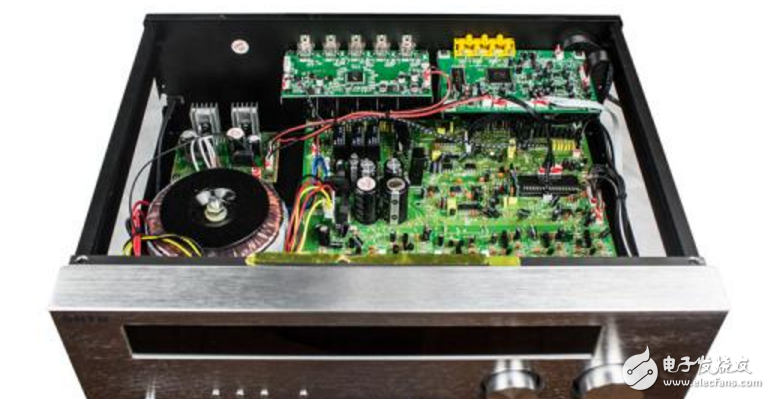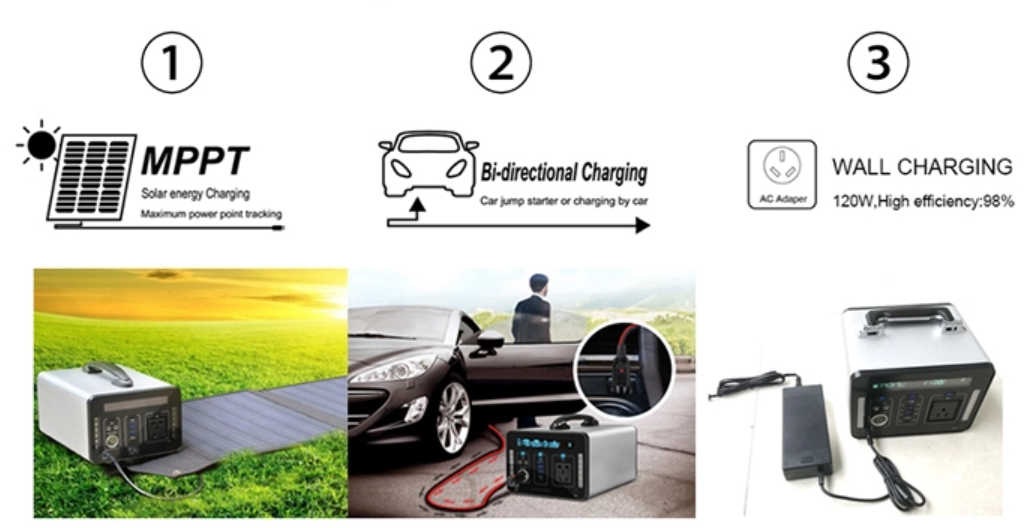1, pure class A power amplifier
A pure class A power amplifier, also known as a Class A power amplifier (Class A), is a fully linear amplifier form of the amplifier. When a pure Class A power amplifier is operating, the positive and negative channels of the transistor are normally open regardless of the presence or absence of a signal, which means more power is dissipated as heat. Pure Class A power amplifiers are rare in automotive audio applications, such as the Italian Sinfoni high-quality series. This is because the efficiency of a pure class A power amplifier is very low, usually only 20-30%, and audiophiles are relishing its sound.
2. Class B power amplifier
Class B power amplifiers, also known as Class B power amplifiers (Class B), are also known as linear amplifiers, but they work in a completely different way than pure Class A power amplifiers. When class B power is put into operation, the positive and negative channels of the transistor are usually in the off state unless there is signal input, that is, only the positive phase channel works when the positive phase signal comes, and the negative phase channel is closed. It won't work at the same time, so there is no power loss in the part without signal. However, when the positive and negative channels are turned on and off, crossover distortion is often generated, especially in the case of low level, so the class B power amplifier is not a true high fidelity power amplifier. In practical applications, in fact, many of the early car audio amplifiers were Class B amplifiers because of their high efficiency.
3. Class A and B power amplifiers
Class A and B power amplifiers, also known as Class AB power amplifiers (Class AB), are a design that is compatible with Class A and Class B amplifiers. When there is no signal or the signal is very small, the positive and negative channels of the transistor are always open, and the power is lost, but there is no serious class A power amplifier. When the signal is positive, the negative phase channel is normally open before the signal becomes strong, but the signal is strong and the negative channel is closed. When the signal is a negative phase, the positive and negative channels work just the opposite. The defect of Class AB power amplifier is that it will produce crossover distortion, but it is better than Class A and Class B power amplifiers compared with its efficiency ratio and fidelity. Class AB power amplifier is also the most widely used design in car audio. .
4, Class C amplifier
To put it bluntly, it is working in a distorted state! Class C was used for RF power amplification in the early days. Because FM RF output is available, the carrier is adjusted by adjusting the frequency. All the distortions do not affect the frequency. However, some enthusiasts have recently adopted it because of its high efficiency. There are also research directions in which it is applied to audio. But the more popular D-class efficiency is also very high recently~ There are also T-class amplifiers, I am looking for it myself~ I don't know how to ask me~ I hope my answer can help you.
5, class D power amplifier
Class D amplifiers differ from the above-mentioned A, B or AB amplifiers in that their operating principle is based on switching transistors that can be fully turned on or completely turned off in a very short period of time. The two transistors do not turn on at the same time, so there is very little heat generated. This type of amplifier is extremely efficient (about 90%), ideally 100%, compared to only 78.5% for Class AB amplifiers. On the other hand, however, the switching mode of operation also increases the distortion of the output signal. The circuit of the class D amplifier is divided into three levels: an input switching stage, a power amplification stage, and an output filtering stage. Class D amplifiers operate in pulse-width modulated (PWM) mode when switched. The PWM can convert the audio input signal into a high frequency switching signal, and compare the audio signal with the high frequency triangular wave through a comparator. When the voltage of the inverting terminal is higher than the voltage of the non-inverting terminal, the output is low; when the inverting end When the voltage is lower than the voltage at the non-inverting terminal, the output is high.
In a class D amplifier, the output of the comparator is connected to a power amplifier circuit that uses a metal oxide field effect transistor (MOSFET) instead of a bipolar transistor (BJT) because the former has a faster response time and is therefore suitable. In high frequency mode of operation. Class D amplifiers require two MOSFETs that can operate fully in an on or off state in a very short period of time. When a MOSFET is fully turned on, its tube voltage drop is low; when the MOSFET is completely turned off, the current through the tube is zero. The switching speed of the two MOSFETs operating in the on and off states is very fast, so the efficiency is extremely high, and the heat generated is very low, so the class D amplifier does not require a large heat sink.
Class D amplifiers have many other notations, such as T, which are all variants of Class D amplifiers. In practical applications, until the 1980s, this type of switching power amplifier was rapidly developed due to the emergence of MOSFETs. In the actual development process, although there is high efficiency, it also has high distortion, high noise and poor damping factor. With the development of technology, such defects will be less and less, and it is estimated that the future class D power will be more widely used in the field of car audio.

1. Class A power amplifier (also known as Class A power amplifier)
Two (or two) of the transistors in the output stage of the Class A amplifier are always in a conducting state, that is, they maintain conduction current regardless of the presence or absence of signal input, and make these two currents equal to the peak value of the AC, at which time the AC is at the maximum signal. In case of flow into the load. When there is no signal, the two transistors each circulate an equal amount of current, so there is no unbalanced current or voltage at the output center point, so no current is input to the speaker. When the signal goes to the positive side, the output transistor above the line allows more current to flow in, and the lower output transistor reduces the current relatively. As the current begins to unbalance, it flows into the speaker and pushes the speaker to sound.
Class A amplifiers work best in linearity. Each output transistor amplifies the full-wave signal. There is no switching distortion (Switching DistorTIon). Even if negative feedback is not applied, its open-loop distortion is still very low. It is known as the most ideal amplifying circuit design for sound. However, this design has advantages and disadvantages. The biggest disadvantage of Class A power amplifiers is their low efficiency. Because there is still full current flowing in the absence of signals, all the energy is converted into high heat. As the signal level increases, some of the power can enter the load, but many still turn into heat.
Class A amplifiers are ideal for replaying music. They provide a very smooth sound quality, a rounded and warm tone, and a high-pitched transparent opening. These advantages are enough to compensate for its shortcomings. Class A power amplifiers generate amazing heat. In order to effectively deal with heat dissipation, Class A amplifiers must use large radiators. Because of its low efficiency, the power supply must be able to supply sufficient current. A 25W Class A power amplifier is capable of at least 100 watts of Class AB amplifiers. Therefore, the size and weight of the Class A machine are larger than those of the AB class, which increases the manufacturing cost and the price is relatively expensive. In general, Class A amplifiers sell for about twice or more the price of Class AB amplifiers.
2. Class B power amplifier (Class B power amplifier)
Class B amplifier amplification works in such a way that when there is no signal input, the output transistor is not conducting, so no power is consumed. When there is a signal, each pair of output tubes is amplified by half of the waveform, and each of the output tubes is turned on and off to complete a full-wave amplification, and crossover distortion occurs when the two output transistors are rotated, thus forming a nonlinearity. Pure Class B amplifiers are less, because the distortion is very severe when the signal is very low, so the crossover distortion makes the sound rough. Class B amplifiers have an average efficiency of about 75%, which produces less heat than Class A machines, allowing the use of smaller heat sinks. Class B power amplifiers are usually divided into OCL and BTL. BTL can provide more power. At present, most power ICs can use two blocks to form a BTL circuit.
3. Class AB power amplifier
Compared with the first two types of power amplifiers, class AB amplifiers can be said to compromise in performance. Class AB amplifiers typically have two bias voltages, and a small amount of current is passed through the output transistors when there is no signal. It uses the Class A mode of operation to obtain the best linearity in the signal hour. When the signal is raised to a certain level, it automatically switches to the Class B mode of operation for higher efficiency. The general-purpose 10 watt class AB amplifier works in class A within about 5 watts. Since the power required to listen to music is only a few watts, the class AB power is placed in class A power amplifier mode most of the time, only in the presence of music. Turned to Class B when the transient is strong. This design is a logical design with excellent sound quality and improved efficiency to reduce heat. Some Class AB amplifiers have a high bias current, allowing them to work in Class A over a wider power range, making the sound close to a pure Class A machine, but the amount of heat generated is relatively increased.
4. Class C power amplifier (C Class A power amplifier)
This type of amplifier is less heard, because it is a very distorted amplifier and is only suitable for communication purposes. Class C machines have exceptionally high output efficiency, but are not suitable for HI-FI amplification.
5, Class D power amplifier (Ding amplifier)
This design is also known as digital power amplifier. When the transistor of the class D amplifier is turned on, its load is directly connected to the power supply, and the current flows but the transistor has no voltage, so there is no power consumption. When the output transistor is turned off, all of the power supply voltage appears on the transistor, but there is no current, so it does not consume power, so the theoretical efficiency is 100%. The advantage of Class D power amplifier amplification is that the efficiency is the highest, the power supply can be reduced, and almost no heat is generated. Therefore, a large heat sink is not required, and the volume and weight of the body are significantly reduced, and the theoretical distortion is low and the linearity is good. However, this kind of power amplifier work is complicated, and the added line itself is inevitably biased, so the products that are really successful are few and the price is not cheap.
PS: At present, most multimedia speakers use Class B (Class B) amplifiers, and due to cost and space reasons, the power amplifier circuits of multimedia speakers are mostly integrated circuits, and power transformers and filter capacitors cannot be made very large. . This directly affects the sound quality and dynamics of the multimedia box. Of course, the amplifiers that use the tube amplifiers (such as the Great Classic) are working in Class A, but the price of the speakers is not acceptable to most people.
The amplifier is divided into output channels by:
Mono, stereo two-channel, 2.1-channel, 5.1 surround sound
Why Use Battery-powered Generator?

When camping outdoors, a sufficient power supply enables you to enjoy modern convenience. Mobile phones, flashlights, tablets, etc. are inseparable from power support. Besides, when camping for a long time, you may also need to carry high-power appliances such as laptops, drones, and electric kettles, mini fans. Some campers have carried a fuel generator along with their trips. However, the fuel generator is bulky and not portable. It needs to be moved far when using. Also, the loud noise is a major pain point. Therefore, UFO POWER has launched this Portable Solar Generator to help solve the problem of outdoor camping power supply. The rated output power of this portable power station is up to 500W and 1000W.
This UFO lithium portable power station will allow you to enjoy a better outdoor time or deal with emergency situations. One of the best features is the fan-free design. Without noisy motors or noxious exhaust fumes, this portable power station is clean for use and provides a no noise and peaceful environment in the quiet dark night for users.
Mobility, portability, versatility are three main advantages of portable power station.
- Mobility refers to the on-the-go power solution wherever you are. Users can recharge their digital appliances anywhere, such as in a forest adventure, on the top of mountains, or even in a basement.
- Portability means the compact size and light weight of this power station. The UFO solar generators are equipped with lithium batteries, which can provide a safe and perfect battery performance with a longer service life. UFO POWER offers 500Wh and 1000Wh portable power station to cater to your specific needs for power supply.
Multi-Function Power Supply Device
It is a safe, clean and reliable power source which is mighty enough to charge various mobile devices, laptops, and it can even power the most demanding electrical appliances.The UFO portable power station is a range of rechargeable lithium batteries providing several ways of power supply, including
·AC Power Socket
·12V DC Port
·USB Port
·Type-C Port
·Car Jump Starter
Three ways to charge the solar generator
1.AC Wall Outlet2.Car Charging
3.Solar Panel Charging

Wide Application
-- Storm
-- Power Failure
-- Emergency
-- CPAP
-- Fishing
-- Camping

Long Service Time for Electronic Gear

1000Wh Portable Power Station,Solar Generator With Panels,Outdoor Power Station,Portable Solar Power Station
ShenZhen UFO Power Technology Co., Ltd. , https://www.ufobattery.com